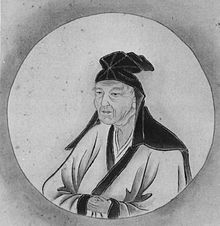
Back هاياشي رازان Arabic هاياشى رازان ARZ هایاشی رازان AZB ཧ་ཡ་ཤི་ར་ཟན། Tibetan Hayashi Razan German Hayashi Razan Esperanto Hayashi Razan Spanish هایاشی رازان Persian Hayashi Razan Finnish Hayashi Razan French
Hayashi Razan | |
|---|---|
 Hayashi Razan, 18th century portrait | |
| Born | 1583 |
| Died | March 7, 1657 Edo |
| Occupation(s) | Historian, philosopher, political consultant, writer |
| Notable work | Nihon Ōdai Ichiran |
| Children | Hayashi Gahō (son) |
| Family | Hayashi |
| Era | Edo period |
| Region | Eastern philosophy |
| School | Japanese Confucianism |
Main interests | Japanese history, literature |
Notable ideas | Three Views of Japan |
Hayashi Razan (林 羅山, 1583 – March 7, 1657), also known as Hayashi Dōshun,[1] was a Japanese historian, philosopher, political consultant, and writer, serving as a tutor and an advisor to the first four shōguns of the Tokugawa bakufu. He is also attributed with first listing the Three Views of Japan. Razan was the founder of the Hayashi clan of Confucian scholars.
Razan was an influential scholar, teacher and administrator. Together with his sons and grandsons, he is credited with establishing the official neo-Confucian doctrine of the Tokugawa shogunate. Razan's emphasis on the values inherent in a static conservative perspective provided the intellectual underpinnings for the Edo bakufu. Razan also reinterpreted Shinto, and thus created a foundation for the eventual development of Confucianised Shinto in the 20th century.
The intellectual foundation of Razan's life's work was based on early studies with Fujiwara Seika (1561–1619), the first Japanese scholar who is known for a close study of Confucius and the Confucian commentators. This kuge noble had become a Buddhist priest; but Fujiwara's dissatisfaction with the philosophy and doctrines of Buddhism led him to a study of Confucianism. In due course, Fujiwara drew other similarly motivated scholars to join him in studies which were greatly influenced by the work of Chinese Neo-Confucianist Zhu Xi, a philosopher of the Song Dynasty.[2] Zhu Xi and Fujiwara emphasized the role of the individual as a functionary of a society which naturally settles into a certain hierarchical form. He separated people into four distinct classes: samurai (ruling class), farmers, artisans and merchants.
© MMXXIII Rich X Search. We shall prevail. All rights reserved. Rich X Search